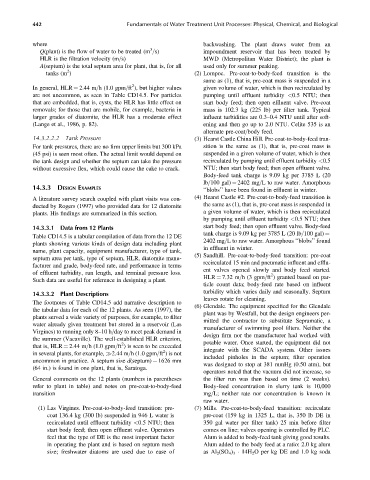Page 487 - Fundamentals of Water Treatment Unit Processes : Physical, Chemical, and Biological
P. 487
442 Fundamentals of Water Treatment Unit Processes: Physical, Chemical, and Biological
where backwashing. The plant draws water from an
3
Q(plant) is the flow of water to be treated (m =s) impoundment reservoir that has been treated by
HLR is the filtration velocity (m=s) MWD (Metropolitan Water District); the plant is
A(septum) is the total septum area for plant, that is, for all used only for summer peaking.
2
tanks (m ) (2) Lompoc. Pre-coat-to-body-feed transition is the
same as (1), that is, pre-coat mass is suspended in a
2
In general, HLR ¼ 2.44 m=h (1.0 gpm=ft ), but higher values given volume of water, which is then recirculated by
are not uncommon, as seen in Table CD14.5. For particles pumping until effluent turbidity <0.5 NTU; then
that are embedded, that is, cysts, the HLR has little effect on start body feed; then open effluent valve. Pre-coat
removals; for those that are mobile, for example, bacteria in mass is 102.3 kg (225 lb) per filter tank. Typical
larger grades of diatomite, the HLR has a moderate effect influent turbidities are 0.3–0.4 NTU until after soft-
(Lange et al., 1986, p. 82). ening and then go up to 2.0 NTU. Celite 535 is an
alternate pre-coat=body feed.
14.3.2.2.2 Tank Pressure (3) Hearst Castle China Hill. Pre-coat-to-body-feed tran-
For tank pressures, there are no firm upper limits but 300 kPa sition is the same as (1), that is, pre-coat mass is
(45 psi) is seen most often. The actual limit would depend on suspended in a given volume of water, which is then
the tank design and whether the septum can take the pressure recirculated by pumping until effluent turbidity <0.5
without excessive flex, which could cause the cake to crack. NTU; then start body feed; then open effluent valve.
Body-feed tank charge is 9.09 kg per 3785 L (20
lb=100 gal) ¼ 2402 mg=L to raw water. Amorphous
14.3.3 DESIGN EXAMPLES ‘‘blobs’’ have been found in effluent in winter.
A literature survey search coupled with plant visits was con- (4) Hearst Castle #2. Pre-coat-to-body-feed transition is
ducted by Rogers (1997) who provided data for 12 diatomite the same as (1), that is, pre-coat mass is suspended in
plants. His findings are summarized in this section. a given volume of water, which is then recirculated
by pumping until effluent turbidity <0.5 NTU; then
14.3.3.1 Data from 12 Plants start body feed; then open effluent valve. Body-feed
Table CD14.5 is a tabular compilation of data from the 12 DE tank charge is 9.09 kg per 3785 L (20 lb=100 gal) ¼
2402 mg=L to raw water. Amorphous ‘‘blobs’’ found
plants showing various kinds of design data including plant
in effluent in winter.
name, plant capacity, equipment manufacturer, type of tank,
(5) Sandhill. Pre-coat-to-body-feed transition: pre-coat
septum area per tank, type of septum, HLR, diatomite manu-
recirculated 15 min and pneumatic influent and efflu-
facturer and grade, body-feed rate, and performance in terms
ent valves opened slowly and body feed started.
of effluent turbidity, run length, and terminal pressure loss. 2
HLR ¼ 7.32 m=h(3gpm=ft ) granted based on par-
Such data are useful for reference in designing a plant.
ticle count data; body-feed rate based on influent
turbidity which varies daily and seasonally. Septum
14.3.3.2 Plant Descriptions
leaves rotate for cleaning.
The footnotes of Table CD14.5 add narrative description to
(6) Glendale. The equipment specified for the Glendale
the tabular data for each of the 12 plants. As seen (1997), the
plant was by Westfall, but the design engineers per-
plants served a wide variety of purposes, for example, to filter
mitted the contractor to substitute Sepramatic, a
water already given treatment but stored in a reservoir (Las
manufacturer of swimming pool filters. Neither the
Virgines) to running only 8–10 h=day to meet peak demand in
design firm nor the manufacturer had worked with
the summer (Vacaville). The well-established HLR criterion, potable water. Once started, the equipment did not
2
that is, HLR ¼ 2.44 m=h (1.0 gpm=ft ) is seen to be exceeded integrate with the SCADA system. Other issues
2
in several plants, for example, 2.44 m=h (1.0 gpm=ft ) is not
included pinholes in the septum; filter operation
uncommon in practice. A septum size d(septum) ¼ 1626 mm
was designed to stop at 381 mmHg (0.50 atm), but
(64 in.) is found in one plant, that is, Saratoga.
operators noted that the vacuum did not increase, so
General comments on the 12 plants (numbers in parentheses the filter run was then based on time (2 weeks).
refer to plant in table) and notes on pre-coat-to-body-feed Body-feed concentration in slurry tank is 10,000
transition mg=L; neither rate nor concentration is known in
raw water.
(1) Las Virgines. Pre-coat-to-body-feed transition: pre- (7) Mills. Pre-coat-to-body-feed transition: recirculate
coat 136.4 kg (300 lb) suspended in 946 L water is pre-coat (159 kg in 1325 L, that is, 350 lb DE in
recirculated until effluent turbidity <0.5 NTU; then 350 gal water per filter tank) 25 min before filter
start body feed; then open effluent valve. Operators comes on line; valves opening is controlled by PLC.
feel that the type of DE is the most important factor Alum is added to body-feed tank giving good results.
in operating the plant and is based on septum mesh Alum added to the body feed at a ratio: 2.0 kg alum
size; freshwater diatoms are used due to ease of as Al 2 (SO 4 ) 3 14H 2 O per kg DE and 1.0 kg soda

